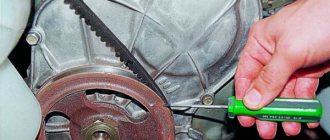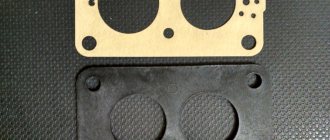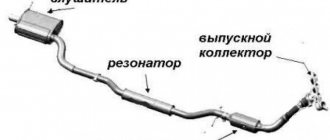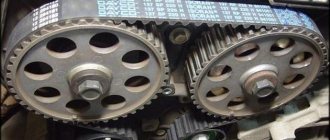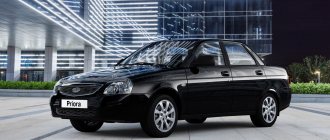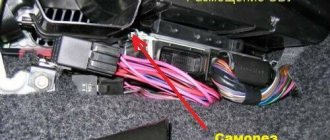The difference – briefly in simple words
To put it briefly and in simple words, synchronous and asynchronous motors differ in the design of their rotors. From the outside, it is almost impossible to understand which electric motor is in front of you, except for the presence of additional cooling fins for asynchronous electric motors.
In a device operating on the synchronous principle, a winding with an independent voltage supply is provided on the rotor.
In an asynchronous motor, current is not supplied to the rotor, but is generated using a magnetic stator field. At the same time, the stators of both units are identical in design and have a similar function - creating a magnetic field.
Additionally, in a synchronous motor, the magnetic fields of the stator and rotor interact with each other and have equal speed.
Asynchronous units have short-circuited metal plates or contact rings in the rotor slots, which ensure a difference in the magnetic field of the rotor and stator mechanism by the amount of sliding.
Despite its apparent simplicity, it is unlikely that it will be possible to deal with this issue right away, so we will consider the issue in more detail. Let's talk about the features and differences between asynchronous and synchronous machines.
Starting electric motors
Asynchronous electric machines with a power of up to 30-50 kW are started by direct supply of electricity. With high-power motors and synchronous machines the situation is more complicated.
Starting high power asynchronous motors
To start such machines, different methods are used:
Starting synchronous electric machines
Unlike asynchronous machines, which are started by the interaction of the stator field and the windings or squirrel cage of the rotor, a synchronous machine must first be accelerated to a speed close to synchronous.
Asynchronous and synchronous motors: device
Electric motors are units for converting electricity into mechanical energy. The basis of the motor design (both synchronous and asynchronous types) is the following elements:
- stationary (stator);
- rotating (rotor).
Stators of electric motors of both categories have a similar design principle. Current-carrying wires made of copper or aluminum are placed in special grooves (axial slots). The function of the stator is to create a rotating magnetic field. The rotor (with field winding) is fixed to the motor shaft and rotates under the influence of the resulting electromotive force.
Design and principle of operation
The main driving force of any electric motor is electromagnetic induction. Electromagnetic induction, to describe it in a nutshell, is the appearance of current in a conductor placed in an alternating magnetic field. The source of the alternating magnetic field is a stationary motor housing with windings placed on it - a stator connected to an alternating current source. It contains a moving element - a rotor, in which current arises. According to Ampere's law, an electromotive force - EMF - begins to act on a charged conductor placed in a magnetic field, which rotates the rotor shaft. Thus, the electrical energy supplied to the stator is converted into mechanical energy by the rotor. Various mechanisms that perform useful work can be connected to the rotating shaft.
AC electric motors are divided into synchronous and asynchronous. The difference between them is that in the first, the rotor and the magnetic field of the stator rotate at the same speed, and in the second, the rotor rotates more slowly than the magnetic field. They differ both in structure and principle of operation.
Asynchronous motor
Windings are attached to the stator of an asynchronous motor, creating an alternating rotating magnetic field, the ends of which are brought out to the terminal box. Since the engine heats up during operation, a cooling fan is installed on its shaft.
The rotor of an asynchronous motor is made with the shaft as a single unit. It consists of metal rods closed to each other on both sides, which is why such a rotor is also called a squirrel-cage rotor. In appearance, it resembles a cage, which is why it is often called a “squirrel wheel”. The slower rotation of the rotor compared to the rotation of the magnetic field is the result of power loss due to friction of the bearings. By the way, if there had not been this difference in speed, the EMF would not have arisen, and without it there would have been no current in the rotor and no rotation itself.
The magnetic field rotates due to the constant change of poles. In this case, the direction of the current in the windings changes accordingly. The rotation speed of an asynchronous motor shaft depends on the number of poles of the magnetic field.
What is a synchronous motor?
Synchronous to be electric motors that operate on alternating current and have a rotor with a rotation speed that matches the speed of the magnetic field in the unit design.
Key elements of a synchronous electric motor:
- anchor;
- inductor.
The first element of the unit is located on the stator. The inductor is placed on the rotor, which is separated from the stator by an air gap. The armature structure is represented by a winding (one or more). The currents that are supplied to the corresponding motor element form a magnetic field that rotates at a given frequency and interacts with the field of the inductor. The inductor includes 2 poles - in the form of permanent magnets.
The synchronous unit can operate in two modes:
- like the electric motor itself;
- like a generator.
The first operating mode involves the interaction of the magnetic field formed at the armature and the field that forms at the poles of the inductor. A synchronous motor in generator mode operates due to electromagnetic induction: during the rotation of the rotor, the magnetic field that is formed on the winding interacts in turn with the phases of the winding on the stator, resulting in the formation of an electromotive force.
Synchronous motor
So, a synchronous electric motor is a motor with a constant rotor speed, plus the ability to regulate this speed. The design of a synchronous motor is quite complex. To understand it, you need to look at the photo below.
It clearly shows that the motor windings are located on the armature or rotor of the unit. The ends of the windings are brought out and secured to the slip ring, or, more precisely, to its sectors. The current itself is supplied to the same ring only through graphite brushes, which are connected to the power supply.
Attention! The ends of the windings are connected in such a way that when the motor is running, the electric current always flows through the brushes to only one pair.
The engine of this model has more vulnerabilities than the asynchronous one.
- Graphite brushes wear out.
- Poor contact between the slip ring and the brushes due to the weakening of the spring, which presses the latter against the ring (commutator).
- Bearings wear out.
- Formation of dirt deposits on the surface of the slip ring.
Now we move on to another position - the principle of operation of a synchronous electric motor. The rotating torque inside the motor is formed due to the interaction of the magnetic field that is formed in the field windings and the current passing through the armature of the unit. But there is one point - the changing direction of the current (alternating) will also change the direction of rotation of the motor’s magnetic field. True, the change in rotation will change both in the body of the apparatus and at the anchor at the same time. That is why the motor rotor always rotates at the same speed.
That is why this value can only be changed by changing the voltage of the electricity supplied to the brushes. Remember vacuum cleaners, where the suction power is changed by a switch that is simply connected to a rheostat. And the power of the vacuum cleaner depends on the rotation speed of the impeller shaft, that is, the electric motor shaft. The higher the speed, the greater the suction power.
Synchronous motor
This type of engine is capable of working both as a generator and as an engine itself. Its device is similar to a synchronous generator. A characteristic feature of the engine is the constant rotor speed depending on the load.
These types of motors are widely used in many applications, such as electrical wires that require constant speed.
Control system
If the electromechanical part consists primarily of three components, including a rotor, a stator and a supporting structure in the form of a housing, then the control infrastructure is more segmented - the number of elements can reach several dozen. Another thing is that they can be divided into types. Only the inverter will be presented in the singular. It is responsible for switching functions, connecting and switching phases. The main tasks of control with the supply of signals are performed by sensors. The main one is the rotor position detector. In addition, a signal regulation system is also included in the control unit. This is a node with keys, through which the connection between sensors and electromechanical components is realized.
Information about the rotor position is processed by a microprocessor. Externally, the interface of this block is a control panel. At reception, it works with pulse width modulation signals (PWM signal). If the supply of low-voltage signals is provided, then a transistor bridge is also installed in the control unit. It converts the signal into power voltage, which is subsequently supplied to the electric motor. The presence of sensors with a pulse processing system is what distinguishes the control of a valve motor from the means of monitoring brush-commutator units. Another thing is that the possibility of introducing electronic equipment with sensors is also allowed in commutator machines along with mechanical control systems.
Asynchronous motor
This type of device is a mechanism aimed at transforming alternating current electrical energy into mechanical energy. From the very name “asynchronous” we can conclude that we are talking about a non-simultaneous process. Indeed, the rotation frequency of the stator magnetic field here is always higher than the rotor one. Such a device consists of a cylindrical stator and a rotor, depending on the type of which squirrel-cage asynchronous motors can also have a phase-wound rotor.
Work principles
All electric motors have a stationary stator and a rotating rotor. The difference between asynchronous and synchronous motors lies in the principles of pole creation. In an asynchronous electric motor they are created by the phenomenon of induction. All other electric motors use permanent magnets or current-carrying coils to create a magnetic field.
Features of synchronous motors
The driving units of a synchronous machine are the armature and the inductor. The armature is the stator, and the inductor is located on the rotor. Under the influence of alternating current, a rotating magnetic field is formed in the armature. It meshes with the magnetic field of the inductor formed by the poles of permanent magnets or coils with direct current. As a result of this interaction, electrical energy is converted into kinetic rotational energy.
The rotor of a synchronous machine has a rotation frequency that is the same as that of the stator field. Advantages of synchronous electric motors:
- Structurally, it is used both as an engine and as a generator.
- Rotation speed independent of load.
- High efficiency.
- Low labor intensity in repair and maintenance.
- High degree of reliability.
Synchronous machines are widely used as high power electric motors for low rotation speed and constant load. Generators are used where an autonomous power source is required.
The synchronous machine also has disadvantages:
- A DC source is required to power the inductor.
- There is no initial starting torque; starting requires the use of external torque or asynchronous starting.
- Brushes and commutators quickly fail.
Modern synchronous units contain in the inductor, in addition to the winding powered by direct current, a starting short-circuited winding, which is designed for starting in asynchronous mode.
Distinctive features of asynchronous motors
The rotating magnetic field of the stator of an asynchronous motor induces induced currents in the rotor, which form their own magnetic field. The interaction of the fields causes the rotor to rotate. The rotor rotation speed lags behind the rotation frequency of the magnetic field. It is this property that is reflected in the name of the engine.
There are two types of asynchronous electric motors: squirrel cage and wound rotor.
Household appliances, such as a fan or vacuum cleaner, are usually equipped with squirrel-cage motors, which are squirrel-cage motors. All rods are closed by discs welded on both sides. The interaction of the stator magnetic field with induced currents in the rotor forms an electromagnetic force that acts on the rotor in the direction of rotation of the stator field. The torque on the electric motor shaft is created by all the electromagnetic forces from each conductor.
An electric motor with a wound rotor uses the same stator as a motor with a squirrel-cage rotor. And windings of three phases connected into a “star” are added to the rotor. When starting the engine, you can connect rheostats to them that regulate starting currents. Using rheostats, you can also regulate the engine speed.
The advantages of asynchronous motors include:
- Powered directly from AC mains.
- Simplicity of the device and relatively low cost.
- Possibility of use in household appliances using a single-phase connection.
- Low energy consumption and economical.
Serious disadvantages are difficult speed control and large heat losses. To prevent overheating, the unit body is made ribbed, and an impeller is installed on the electric motor shaft for cooling.
Comparison of synchronous and asynchronous motors
In conclusion, we can summarize what are the main differences between asynchronous (AM) and synchronous (SD) motors.
Let's highlight the basic points:
- The rotor of asynchronous motors does not require current supply, and the induction at the poles depends on the stator magnetic field.
- The IM revolutions under load lag by 1-8% from the rotation speed of the stator field. In SD, the number of revolutions is the same.
- The “synchronizer” has an excitation winding.
- Structurally, the rotor of an SD is a magnet: permanent, electric. In IM, the magnetic field in the rotor mechanism is induced using induction.
- A synchronous machine does not have a starting torque, so an asynchronous start is needed to achieve synchronization.
- “Synchronizers” are used in cases where it is necessary to ensure continuity of the production process and there is no need for frequent restarts. IMs are needed where high starting torque is required and frequent stops occur.
- The LED needs an additional current source.
- “Asynchronous” wear out more slowly, because in their design there are no slip rings with brushes.
- As a rule, blood pressure is characterized by a non-round number of revolutions, while SD is characterized by a rounded number.
AC motors
They are in higher demand than DC motors. They are often used in everyday life and in industry. Their production is much cheaper, the design is simpler and more reliable, and operation is quite simple. Almost all household appliances are equipped with AC motors. They are used in washing machines, kitchen hoods, etc. In large industries, they are used to drive machine tools, winches for moving heavy loads, compressors, hydraulic and pneumatic pumps and industrial fans.
Table
| Synchronous motor | Asynchronous motor |
| The rotation of the rotor and the magnetic field in synchronous motors occurs at the same frequency | The rotor and magnetic field rotate in asynchronous units at different frequencies |
| Often has a more complex design | Usually has a less complex design |
| Optimal for required power of 100 kW and above | Optimal for required power less than 100 kW |
Comparison
The main difference between a synchronous motor and an asynchronous one is the relationship between the rotor speed and the magnetic field. In the first type of unit, both indicators are the same. In an asynchronous machine - different.
It can be noted that electric motors of the second type are generally more common than the first. At the same time, asynchronous units are most often presented in a variety in which a squirrel-cage rotor is installed. These devices have a number of important advantages over electric motors of other categories. Namely:
At the same time, asynchronous machines with a squirrel-cage rotor also have a number of disadvantages. Namely:

